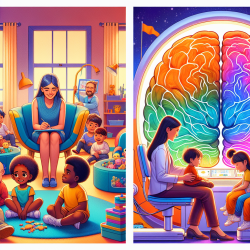Introduction
As practitioners dedicated to improving the lives of children, we must continually seek out innovative methods to enhance our therapeutic approaches. One such avenue is the integration of neuroimaging insights into our practice. A recent study, "Neuroimaging Adolescents with Depression in a Middle-Income Country: Feasibility of an fMRI Protocol and Preliminary Results," provides valuable insights that can be leveraged to improve outcomes for children with depression.
Understanding the Study
The study explored the feasibility of implementing a complex neuroimaging protocol in a middle-income country. It focused on adolescents with major depressive disorder (MDD), utilizing resting-state functional magnetic resonance imaging (rs-fMRI) to examine brain connectivity patterns. The research revealed significant connectivity in three major networks: the default mode network (DMN), the salience network (SN), and the cognitive control network (CCN).
Key Findings and Implications
- Feasibility in Middle-Income Settings: The study demonstrated that high-quality neuroimaging protocols can be implemented in middle-income countries, paving the way for more inclusive global research.
- Connectivity Patterns: The observed connectivity patterns in adolescents with depression were consistent with findings from high-income countries, suggesting universal aspects of depression's neurobiology.
- Data-Driven Interventions: Understanding these connectivity patterns can guide the development of targeted interventions, potentially improving therapeutic outcomes for children with depression.
Enhancing Therapeutic Practices
For practitioners in speech-language pathology and related fields, these findings underscore the importance of integrating neurobiological insights into therapeutic practices. By understanding the underlying brain connectivity patterns associated with depression, we can tailor interventions to better address the specific needs of each child.
Moreover, the study highlights the potential for neuroimaging to inform early identification and intervention strategies, particularly in middle-income countries where resources may be limited. By leveraging these insights, practitioners can contribute to reducing the global burden of youth depression.
Encouraging Further Research
While this study provides a promising foundation, further research is essential to fully understand the implications of neuroimaging findings for therapeutic practice. Practitioners are encouraged to engage with ongoing research efforts and consider how these insights can be applied in their own work.
Conclusion
The integration of neuroimaging insights into therapeutic practices offers a powerful tool for enhancing outcomes for children with depression. By staying informed about the latest research and embracing data-driven approaches, practitioners can make a meaningful impact on the lives of the children they serve.
To read the original research paper, please follow this link: Neuroimaging adolescents with depression in a middle-income country: feasibility of an fMRI protocol and preliminary results.










